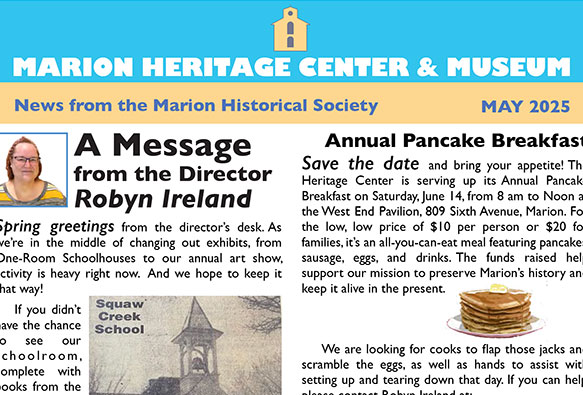Charlie Carrington wasn’t the first popcorn man in Marion’s City Square Park, nor was he the last. But he was there through the Depression and World War II, continuing a tradition that began in 1914.
For twenty-two years, every afternoon from April into November, Charlie came to his little white stand, on the NE corner of the park; a shed really, about ten or fifteen feet wide, perhaps five feet deep, room enough only for Charlie, a chair, his popper and his supplies. He put on his green visor and began parceling out yesterday’s leftovers, free to kids and squirrels. The squirrels came out of the trees when Charlie tapped on this counter; the kids needed no reminder.
Charlie’s wife once said that he popped a ton of corn a year. If this was an accurate measure, we are permitted some estimates. Let’s say a five-cent bag of popped corn weighs an ounce. With sixteen bags to a pound, a ton of corn yields thirty-two thousand nickel bags, which turns into $1,600 in gross sales. Perhaps Charlie did it for love.
It had taken a tragedy for him to get into the popcorn business. Charlie had been a railroad man, working out of Marion on the Milwaukee line. A freight train conductor (or brakeman in some references) and considered “one of the best men on the run,” according to the Marion Sentinel.
On December 6, 1930, Charlie was working with other trainman to switch cars in the rail yards in Savannah, Illinois. He may have been standing atop a freight car, but in any event he fell across the tracks as the car began to move. The cars wheels rolled over his legs, severing one. The other leg was amputated at the hospital. He was forty-two years old.
Depressed and frightened about the future, Charlie looked out his hospital window one day and saw a man walk up the icy sidewalk and enter the building. He was a fellow railroad man, and he had come to show Charlie something. Pulling up the trousers, he revealed his two wooden legs. The man had lost his own legs, yet here he was, navigating icy walkways. Charlie was immediately heartened. If he can do it, he thought, so can I.
As soon as he could, Charlie went to the Artificial Limb Company in Council Bluffs and got himself fitted with two artificial legs. He spent three months on crutches and three more on a cane until he could walk without assistance on legs and feet of English willow.
By that time he had purchased the popcorn stand from the estate of Pete Kassler and was operating it under a permit from the town. Kassler had been a blacksmith who suffered an injury that paralyzed his legs. In granting the license to Charlie, Marion’s city fathers continued the practice of awarding the permit “to allow a means of a living” to a person with a handicap.
Charlie must have been busiest on summer evenings after the war when the high school band played concerts in the park. Folks arrived before twilight. Some sat on the park’s green benches; others brought canvas chairs or spread out blankets on the grass. And they bought popcorn, and the smell of it popping scented the air. A fragrant cloud spread over the park, wafted over the whole business district, enveloping everyone.
Now the high school band took the stage, as many as fifty strong, dressed in white, short-sleeved shirts. Paul Wright, the bandleader, tall and serious, took his place. He studied his musicians for a moment, tapped his baton on his music stand, and raised his arms over his head. The first number would be a Sousa march, a lively opening to the hour-long concert. People stopped talking, hushed their children, and settled back to listen.
In the brief silence before Mr. Wright struck up the band, the concertgoers just might have heard, off to their left, the soft rattle of Charlie’s corn pop-popping like a distant drum, tapping out its own cadence, making it own music, working its own magic.



